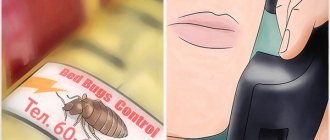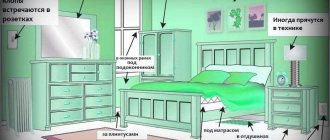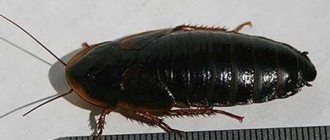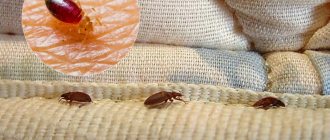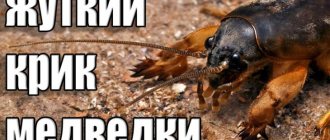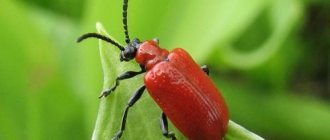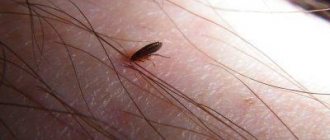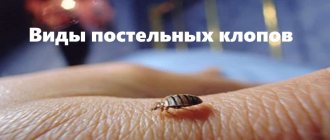- By Vil Malinoshevsky
- About cockroaches
Cockroach larvae are the most dangerous part of the entire population of cockroaches in an apartment for people.
Firstly, there are the most of them here and they are the ones who bring the largest amount of various contaminants into the room and onto food products in the room from sewers, garbage chutes, entrances and other less clean places in the house.
Secondly, it is the larvae of domestic cockroaches that are the source of strong allergens, due to which, perhaps, some of the people living in the house constantly have a stuffy nose and develop chronic allergic rhinitis. Young children are especially sensitive to these allergens - a significant part of children's runny noses, which are not accompanied by an increase in temperature, are caused by cockroach nymphs.
What kind of allergens are these and why are cockroach larvae more dangerous as carriers of allergens than adults?
What do cockroach larvae look like?
The photo below shows the larvae of the most common red cockroaches, colloquially Prussians, or Stasiks:
The red longitudinal stripe on the pronotum of the insect is clearly visible
Depending on age, their length ranges from 1 to 9 mm. When you walk into the kitchen at night, turn on the light and see cockroaches of different sizes scattering across the table and walls, know that all small cockroaches are larvae.
Cockroach larva on a cutting board
The larvae are very similar in body shape and color to adult cockroaches. Here nearby are an adult Prussian and several nymphs of different ages. Surely you see that these nymphs are smaller copies of an adult insect, and also without wings. They even have red and black stripes on the pronotum that form the same pattern, except that they are slightly wider.
Preventive actions
- Keep your house clean. Good sanitation is the best way to prevent cockroaches.
- Don't leave food out overnight. You need to wash dirty dishes every day. Wipe up crumbs and spills, even in cabinets and pantries. Clean kitchen counters with disinfectant spray at night. Don't forget to clean your kitchen appliances. Cockroaches love to eat grease and leftover food, finding it everywhere, including the refrigerator, stove, dishwasher, microwave, toaster and under the kitchen sink.
- Limit your food intake to one room. Not only will this make cleaning easier, but it will also cut down on crumbs and spills that you might not notice in other rooms, which are another source of food for cockroaches.
- Store all food in sealed containers. This also applies to pet food. Pet bowls and food containers should also be emptied every night.
- Make sure your trash can has a tight-fitting lid and dispose of trash in the evening. Make sure outside trash cans are clean and away from your home.
- You need to vacuum the rooms in your home every 2-3 days. It helps to get rid of excrement, body parts and egg capsules. They contain pheromones that attract other cockroaches to your home.
- Get rid of entry points. You will need caulking around the utility pipes. Make sure windows and doors are properly sealed. Seal all cracks and crevices.
- Remove anything that the cockroach might use for shelter, such as cardboard and paper.
Are nymphs and larvae of a cockroach the same thing?
Cockroach larvae are often called nymphs.
The fact is that in entomology the term “nymph” is used for immature stages of development of insects and some other arthropods, which are similar in appearance to adults and differ primarily in their inability to reproduce.
If you remember, for example, the differences between a larva and an adult butterfly, then you will agree that these differences are radical - the caterpillar is completely different from the adult butterfly, leads a completely different lifestyle, eats different food. Similarly, in beetles, mosquitoes, fleas, ants, bees and wasps, the larvae are completely different from the adults. All these groups of species belong to insects with the so-called complete transformation.
Butterfly and caterpillar of different types
Cockroaches are insects with incomplete transformation. Their larvae are very similar in appearance to adult individuals and differ from them only in size, underdeveloped reproductive system and, in some species, the absence of wings. For example, both adults and larvae of Madagascar cockroaches do not have wings.
Accordingly, cockroach larvae lead the same lifestyle as adults, eat the same food, and live in the same places. They are sensitive to the same agents that poison adult cockroaches and die at the same temperatures. It has been shown that all red and black cockroaches - both adults and larvae - die in a few hours at a light frost of 2-3 degrees, and in less than an hour at a temperature of +45 degrees. By the way, this can be used to fight them - you can heat the kitchen with a heat gun to 45-50 degrees, maintain this temperature for 2-3 hours, kill them all and be sure that the cockroaches died here along with the larvae.
Similarly, insects with incomplete transformation are bedbugs, crickets, grasshoppers, lice, and dragonflies. In all of them, the larvae are similar to adults and are called nymphs. Dragonflies also have the name naiad for this stage, since, unlike typical nymphs, they lead an underwater lifestyle that is radically different from the lifestyle of adults, although they are similar in appearance to adults.
For example, the photo below shows nymphs of black house cockroaches. One of them has just moulted and the coverings of her body are still soft and white.
It is these cockroaches that have just changed their coats that are called white, and they can sometimes be found in an apartment, although in general such encounters are rare - cockroaches are very vulnerable during molting and prefer to experience this process in very reliable shelters.
Destruction at the embryonic development stage
The larvae of domestic cockroaches are under reliable protection, staying in the ooteca. Not a single toxic substance penetrates through the durable shell. You can only get rid of a clutch of eggs manually if you manage to find the hidden places of the cockroaches. But you cannot be sure of the complete destruction of pests. Females hide clutches with larvae in the most unpredictable places. It is possible to get rid of nymphs only after they are born. Aerosol, spray, dust, traps, solution, poisonous boric acid bait will be effective.
How many larvae hatch from egg capsules and how does this happen?
These are the larvae that hatch from cockroach eggs. These eggs are found in special capsules that females carry at the end of their abdomen. These capsules are called oothecae.
Fresh ootheca at the end of the female's abdomen
By the way, due to the specific nature of gestation of such oothecae in those places where red cockroaches live together with black ones, they displace the black ones. The fact is that in black cockroaches, females carry an ootheca for several days, and then lay them, abandon them to their fate, and the eggs develop for several weeks without protection. In red cockroaches, the female sheds the ootheca immediately before the larvae hatch, a day at most, and therefore protects the eggs to some extent - she can at least escape from predators with the capsule. Red cockroaches safely eat the eggs of black cockroaches if they find leftover oothecae, but black cockroaches cannot eat the eggs of red cockroaches, since they do not attack female cockroaches. As a result, where these species live together, blacks stop reproducing and disappear.
In red cockroaches, an average of 30 larvae emerge from one ootheca, the maximum number is 56, the minimum is 8. This number depends on the conditions in which the cockroaches live. These "newly hatched" larvae are white, translucent and very small. They are usually not visible in housing, because they hide in the most secluded places and do not run out onto open surfaces. They have enough food in various crevices and do not need to run around tables and sinks.
The photo shows cockroach larvae of the first two instars:
The development of the larva lasts about 3-4 months, in ideal conditions – 75 days. During this time, she molts 7 times, and it is after shedding that she grows. The fact is that the coverings of her body are rigid, inelastic, and they do not stretch as the nymph develops. But when she sheds, she sheds her old coat, and the new coat is soft and stretchable in the first 5-6 hours. It stretches them, increases in size, and then this new shell hardens.
For about another 3 weeks, the larva will run around in this hard shell, accumulating strength to molt again and grow again. And when you see cockroaches of various sizes in your kitchen, know that these are larvae of different ages.
So the nymph gradually grows to the last larval stage, which ends with the last molt. With it, an adult cockroach emerges from the shell; if it is a Prussian, then with soft wings that gradually harden and become red. That's it, the larva has turned into an adult insect.
Traces of presence in the house
Cockroaches are nocturnal inhabitants, but they can stay awake during the day. They go fishing mainly in the dark. This is more of a tribute to tradition, because they are not afraid of daylight. However, this behavioral feature allows them to remain unnoticed for quite a long time. How can you determine that you and your family are no longer the only residents of your apartment?
The answer is the same as in the question about the existence of Bigfoot - you need to find traces of life activity. If cockroaches have settled in your house, traces will definitely be found, and this is their main difference from the elusive Yeti.
- They can leave the products of their vital activity, in particular brown excrement, near a water source.
- Where they get into the habit of feeding, sometimes you can even find an ootheca - a capsule with eggs.
- In the cracks under the plinth one comes across translucent chitinous covers - skin shed by the younger generation. They do this about 5 times during their, frankly speaking, not short life by the standards of insects, and therefore there is a real chance of stumbling upon these things and realizing that the seizure of territory has begun.
- Black individuals emit an unpleasant odor, which becomes noticeable when the population is large. So if there is a nasty smell for no apparent reason, there is reason to worry about searching for possible uninvited guests.
If any of the above was found or you personally came face to face with the impudent redhead, urgently stock up on insecticides and use them without mercy.
How to find an insect nest?
The most likely location is near water. Where small individuals appear, beetles breed and feed, traces of their vital activity can usually be found. Where their concentration is maximum, there may be a nest.
Cockroach larvae as the main carriers of dirt and infections into the apartment
It is believed that the main danger posed by cockroaches is the introduction of bacteria and fungal spores from places where garbage accumulates into living quarters. That is, a cockroach that was swarming in the garbage chute in the evening or running along a sewer pipe, after a couple of hours can already crawl into the apartment and run over a piece of bread with the same paws. Which you will eat tomorrow or give to your child. And that's how it really is. How dangerous this is is not clearly known - no one has calculated what proportion of infectious diseases is associated with infection brought specifically by cockroaches. That is, this danger is assumed, although it certainly exists.
By the way…
Cockroach larvae, like adults, do not bite humans. There are reports of exceptions to this rule, but they are not confirmed and cannot be considered the norm. Therefore, if people get bites in an apartment with cockroaches, this means that blood-sucking insects, bedbugs or fleas, live here along with the cockroaches.
And it is from larvae that this danger is most pressing. There are just a lot of them. Each female produces about 30 larvae every 1-2 months. In the apartment they have practically no dangers, most of them survive safely, and during their life there are several hundred larvae for each adult female. That is, the bulk of cockroaches in the apartment are larvae. And starting from the second or third instar, these are fast running larvae.
Consequently, it is they, as the most numerous insects, that migrate in the greatest numbers from dirty locations into the apartment and it is they who bring here the largest amount of different dirt and various infectious agents.
Reproduction process
Domestic red locusts are insects that reproduce sexually. Therefore, the sex of cockroaches, like that of humans, is divided into male and female. You can distinguish a female from a male by body size: male individuals are much smaller. In addition, they have more developed wings, which allow them to land smoothly when falling, which is why people think that they have seen flying cockroaches. Female cockroaches use this organ to attract a male, since it is with mating games that domestic cockroaches begin to reproduce.
By flapping their wings, females secrete a special odorous substance produced by the glands, which attracts the attention of the male.
Insect reproduction process
At the end of the fertilization process, the partners separate: the male goes in search of a new partner to continue mating, and the female prepares to lay eggs.
What happens if you accidentally eat a cockroach larva?
There are times when people call or write to us and ask in a voice with a slight tinge of panic what will happen if they accidentally eat a cockroach larva. Apparently, someone had a similar incident, a child could eat a piece of cookies with a small nymph, or the person himself did it.
Most likely, in this case nothing bad will happen. There is a chance that you will receive some portion of microbes, but you will not swallow anything fatal. So don't worry. But such situations themselves are very eloquent. That is, there is a possibility that a cockroach, which yesterday collected bacteria in the basement, is running through your products today.
Also keep in mind that any chocolate contains the remains of cockroaches in varying quantities. Not ours, of course, but tropical ones, but the difference is small - according to scientists, about half of the cases of chocolate allergy are, in fact, associated with an allergy to the remains of the bodies of cockroaches ground together with cocoa beans.
Therefore, one cockroach that someone accidentally ate with cookies or bread is nothing compared to the number of cockroaches that we constantly eat with chocolate.
